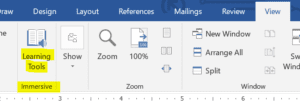Dyslexia is thought to be the most common language-based learning disability. According to Dyslexia Center of Utah as many as 70-80% of people with poor reading skills likely have dyslexia. If we assume this statistic is correct chances are there you have many students who struggle with this issue and go undiagnosed.
What is Dyslexia?
There are many wonderful sites and articles describing how to recognize dyslexia in your students. Of course, a proper evaluation would need to be made by a qualified individual to make a clinical diagnosis; however, the most commonly recognized symptoms included difficulties reading and the tendency to confuse letters, numbers, words, or sequences when reading, writing, or typing.
Strategies for the Classroom
Fonts: The key here is to remember that everyone is different. Some studies show cursive helps while others show that cursive does not help. Some studies show keyboarding skills help while other studies show that font styles matter. If you have a student who is struggling to read first try using different fonts. See if the student has an easier time typing instead of writing. The use of fonts such as Arial or the Dyslexie font can make a huge impact for some students. Avoid using italics and fonts that have flourishes or serifs.
If you find a specific font works for a student, you can simply convert your documents to that font for printouts.
Speech to Text: If you have a bright student who can’t seem to turn in writing assignments and you suspect the may have dyslexia or some other learning disorder you may want to try dictation. Several programs allow for dictation. I find that students have better results when the program has little or no training needed to use the dictation. Because of this, I usually recommend the dictation functions in Microsoft Word or OneNote.
The dictation function is automatic in Word Online and is an add-on in Word 2016 and 2019. It allows students to use dictation in Word with minimal commands. Students only need to learn remember “New Line”, “New Paragraph” and then if they want they can say punctuation commands like “Open Quote”. This strategy does require a computer, and a headset with a microphone but can be useful for many students.
Text to speech: Since many dyslexic individuals struggle to read it is helpful to have text read to them. This can be done using an aid/Paraprofessional or it can be accomplished with technology. Apps like OneNote and Office Lens can allow text to speech for written text as well as books and worksheets. This technology allows students to have things like the whiteboard read to them, or their text book.
This of course does require the use of a devise that has a camera and I usually recommend headphones so that students do not become a distraction for others.
 Immersive Readers: An immersive reader can help with text decoding for students with dyslexia and other reading difficulties. Immersive readers have many options including a simulated color overlay, font options, line focus, and a picture dictionary. As an added benefit it will also read while highlighting the words in the text as they are spoken. Microsoft has included an immersive reader in Word and OneNote. There are even parts of speech indicators.
Immersive Readers: An immersive reader can help with text decoding for students with dyslexia and other reading difficulties. Immersive readers have many options including a simulated color overlay, font options, line focus, and a picture dictionary. As an added benefit it will also read while highlighting the words in the text as they are spoken. Microsoft has included an immersive reader in Word and OneNote. There are even parts of speech indicators.
Next Steps
Everyday there more tools to help struggling readers. With just a few simple tools you can have a lasting impact on these students and improve their learning outcomes by teaching them strategies they will have for a lifetime.
Further reading:
https://www.pearsonclinical.com/education/products/100001918/shaywit-dyslexiascreen.html#tab-pricing
https://www.windowscentral.com/how-microsofts-immersive-reader-tackles-dyslexia-head-and-wins
https://www.bdadyslexia.org.uk/employer/dyslexia-style-guide-2018-creating-dyslexia-friendly-content

Recent Comments